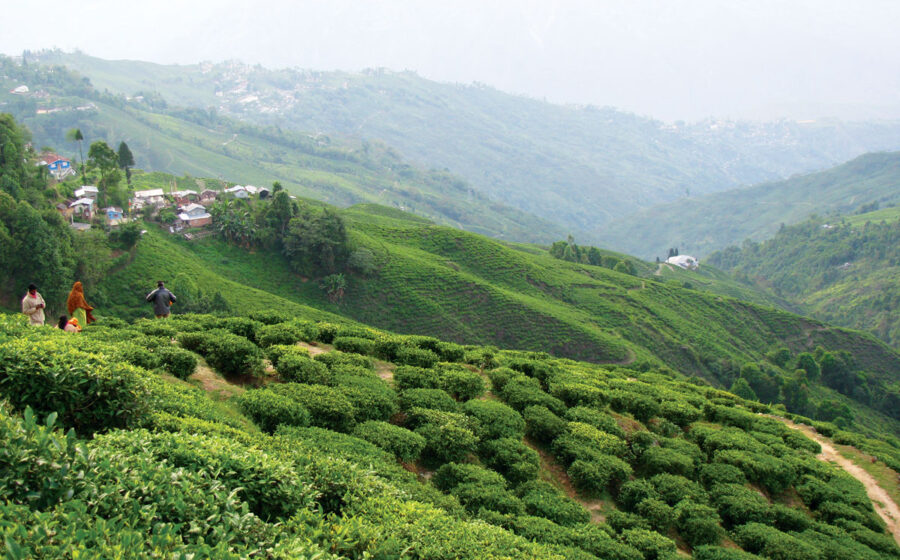[I]n the February issue we discussed the significance—both culturally and in terms of flavor—of early spring-harvested teas in China. Now, we turn to the slopes of India’s Darjeeling region for a look at another seasonal revelation: the first flush harvest of Darjeeling tea, one of tea’s most celebrated picking seasons.
Lovers of Darjeeling tea are well-versed already in its vast world of estate-grown, heirloom-style tea cultivars found in this rainy assemblage of microclimates in the Mahabharata Range. Tea’s arrival in this part of India by smuggling in the 1800s would have a tremendous impact on global tea trade and global trade in general.
The popularly held belief that the fresh air of high, mountainous elevations was beneficial to one’s health—particularly at a time when cholera ran rampant through the lowlands—led to the establishment of a sanitarium in Darjeeling in the early 1800s. A Dr. Campbell, the sanitarium’s superintendent, is credited with planting Darjeeling’s first experimental tea gardens with Chinese seeds from the Kumaon hills of Northern India.
Darjeeling teas can encompass a range of tea varieties and be fired to different degrees, and even more confusingly—and consistent with its cloak-and-dagger history—are prone to being counterfeited.
Having pinpointed Darjeeling as a suitable, perhaps even ideal tea-growing region, the British made efforts to cultivate the area as well as improve their tea-farming techniques, which left something to be desired in terms of producing volume. In one of the most significant moments in agricultural espionage history, a Scottish botanist named, perfectly, Robert Fortune was dispatched to the interior of China (at times in Chinese disguise) to source both tea plants and experts alike, with the goal of creating viable tea agriculture in Darjeeling. It worked. The eventual highly successful propagation of tea in this region would alter trade relations with China and Britain—and the rest of the world—for generations.
Classified as black tea but now often processed closer to an oolong style, Darjeeling teas can encompass a range of tea varieties and be fired to different degrees, and even more confusingly—and consistent with its cloak-and-dagger history—are prone to being counterfeited. When legitimate and well-expressed, Darjeeling’s appellation as a unique-to-region “Champagne of tea” becomes clear within the cup.
First flush Darjeelings represent the earliest of three major harvests, or “flushes” in the region, not counting the mid-flush harvests. First flush begins toward the end of February or early March and can stretch until late April or early May, and yields yellower, clearer, subtly floral and more lightly astringent cups of this famously brisk, muscat grape-esque tea profile. It’s a cup revered for its fresh, crisp, potentially herbaceous qualities, and can be priced much higher than later-year flushes of the same tea bush. As with all early tea harvests, the exact nature of the flavor profile each year will be deeply affected by climate conditions. Tea bushes lie dormant and do not grow here in the winter months, quieted by limited light and cool temperatures, the latter of which are more extreme in high areas like Darjeeling, which at over 2,000 meters is towards the higher end of what tea plants can sustain.
These esteemed first flush teas are followed by a second flush harvest in June, and an autumn flush after that, with rainy season mid-flush harvests known as monsoon flushes taking place between the major harvests. Cup presence increases in color and fullness of body around the second harvest, diminishing in intensity as the year progresses. To enjoy the most from a nuanced first flush Darjeeling, infuse for a shorter time and at a slightly lower temperature than you may be used to for black teas, and forego the temptation—even if it’s your ritual—to add milk.
So as you’re celebrating spring and the slow budding-up of trees and flowers around you, consider a cup of first flush Darjeeling tea to accompany your reflection on new beginnings. After all, that not-so-long-ago arrival of tea in this region was perhaps the most momentous new beginning in the history of tea.
—Liz Clayton is a writer, photographer, and aspiring marmalade chef based in Brooklyn. She is the associate editor of sprudge.com and author of the book Nice Coffee Time.
















